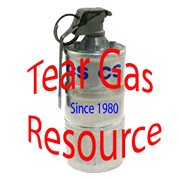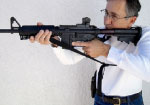One of the big questions I have as a life long chemical agent user and instructor is “Why don’t more agencies use chemical agents at critical incidents?”

One question every SWAT commander should ask himself is whether it is safer to send an officer into a building after a suspect or is it safer for the officers if the suspect exits the building? The answer is let’s deal with the suspect outside the building. Understanding that it is always a case by case decision, but it is always a question that should be asked.
Every time the decision is to send an officer inside to confront a suspect the decision maker should know that he is probably putting the officers and the suspect(s) at more risk. When an officer goes into a suspect’s liar there is probably going to be a fire fight. Those fire fights usually result in someone being greatly injured or dead.
So why would a SWAT Commander decide to send an officer into a building without first trying to make the suspect come out? The biggest reason is that the commander does not know enough about non-lethal chemical agents or that the commander had a bad experience with non-lethal chemical agents when they were officers.
They may not be comfortable putting another dynamic in the management of the event because they feel they already have enough to deal with. Perhaps these commanders have read too much foreign press about how it is evil to use “tear gas” on protestors. They should realize that most of these articles are put out by the protestors themselves.
Some other reasons maybe they:
- Don’t have people trained in chemical agents
- Don’t train enough in chemical agents so they are afraid of the effects.
- The officers and commanders aren’t comfortable working in chemical agents.
- Don’t have the proper equipment to effectively deploy chemical agents.
- Don’t train with respirators so afraid to use them.
- Thinks it is safer for the officer to enter a building without a respirator (more visibility, etc.)
All these excuses can be overcome by training and purchasing the right equipment. Initiate a non-lethal chemical agent program. Appoint a master chemical agent instructor to oversee the program. Most of these doubts or reasons will be overcome.
The last big reason commanders don’t want to use non-lethal chemicals agents for crowd control or removal of barricaded suspects are they are afraid of the possible financial liability. They are afraid of burning a building down and/or having to pay for the clean-up of the building. With today's technologies you never have to set a house on fire. Clean up or decontamination is relatively easy for the officers and following general accepted practices is not difficult for those responsible for the buildings.
Although you are sworn to uphold the law, today's management decisions may fall under a set of laws you didn't learn in the academy. Your decisions must conform to constitutional law and the civil and criminal civil rights laws. A SWAT operator must not only know the provisions of the actual laws, but also have a working knowledge of the associated case law to avoid making decisions that may not pass legal scrutiny. Chemical agent use case law is quickly morphing from a low level of force to a higher level of force.
There are not many cases on the subject and most of them have been in favor of the cities and officers that have used their chemical agents within policy and in controlled amounts.
The last and most important issue is that the SWAT operators that are knowledgeable in the use of non-lethal chemical agents haven’t briefed upper management enough on the benefits of chemical agents in officer safety





